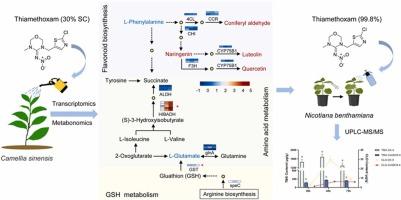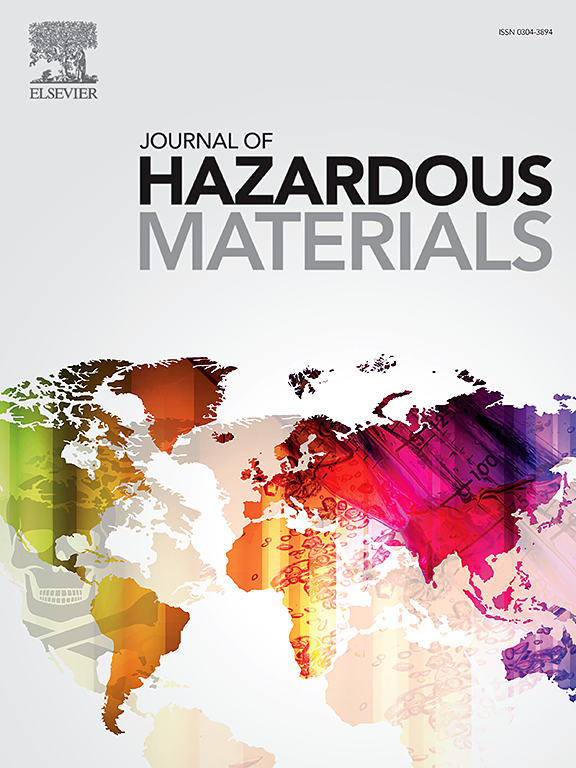Metabolic mechanism, responses, and functions of genes HDH1, HDH3, and GST1 of tea (Camellia sinensis L.) to the insecticide thiamethoxam
IF 11.3
1区 环境科学与生态学
Q1 ENGINEERING, ENVIRONMENTAL
引用次数: 0
Abstract
Misuse of insecticides such as thiamethoxam (TMX) not only affects the quality of tea but also leaves residues in tea. Therefore, exploring the metabolic mechanisms of TMX in tea plants can evaluate effects of pesticides on the environment and human health. Here, effects of TMX on tea plants were studied. Malondialdehyde (MDA) content reached a maximum of 12.59 nmol/g fresh weight (FW) on 1st d under X (the recommended dose: 0.015 kg a.i./ha) of TMX. Under 2 X (0.03 kg a.i./ha), the catalase, glutathione S-transferase and superoxide dismutase activity were increased by 45.0 %, 55.5 %, and 49.7 % at 7 d respectively. Metabolomic and transcriptomic analyses revealed that TMX significantly affected amino acid metabolism, flavonoid biosynthesis and glutathione metabolism, and induced the expression of 3-hydroxyisobutyric acid dehydrogenase genes (CsHDH1 and CsHDH3) and glutathione S-transferase gene (CsGST1). The three genes were transiently expressed in Nicotiana benthamiana for the first time to verify the function of TMX degradation, with the degradation rate of 59.2 %-85.3 % at X. This study elucidated the response of tea plants to abiotic stress on the molecular-scale perspective, and the molecular approaches could serve as a model for the study on pesticide metabolism in plants.
Synopsis
Degradation ability of CsHDH1, CsHDH3 and CsGST1 genes to thiamethoxam was verified for the first time, providing genetic resources for phytoremediation of pollutants.

茶树HDH1、HDH3和GST1基因对噻虫嗪的代谢机制、响应及功能
误用噻虫嗪(TMX)等杀虫剂不仅会影响茶叶品质,还会造成茶叶残留。因此,探讨TMX在茶树体内的代谢机制可以评价农药对环境和人体健康的影响。本文研究了TMX对茶树的影响。在推荐剂量为0.015 kg a.i./ha的TMX处理下,第1 d丙二醛(MDA)含量最高,为12.59 nmol/g鲜重(FW)。在2 X (0.03 kg a.i./ha)处理下,过氧化氢酶、谷胱甘肽s转移酶和超氧化物歧化酶活性在第7 d分别提高了45.0%、55.5%和49.7%。代谢组学和转录组学分析显示,TMX显著影响了氨基酸代谢、类黄酮生物合成和谷胱甘肽代谢,诱导了3-羟基异丁酸脱氢酶基因(CsHDH1和CsHDH3)和谷胱甘肽s转移酶基因(CsGST1)的表达。这三个基因首次在benthamiana中短暂表达,验证了TMX降解的功能,在x处的降解率为59.2% ~ 85.3%。本研究从分子尺度上阐明了茶树对非生物胁迫的响应,分子方法可作为研究植物体内农药代谢的模型。摘要首次验证了CsHDH1、CsHDH3和CsGST1基因对噻虫嗪的降解能力,为植物修复污染物提供了遗传资源。
本文章由计算机程序翻译,如有差异,请以英文原文为准。
求助全文
约1分钟内获得全文
求助全文
来源期刊

Journal of Hazardous Materials
工程技术-工程:环境
CiteScore
25.40
自引率
5.90%
发文量
3059
审稿时长
58 days
期刊介绍:
The Journal of Hazardous Materials serves as a global platform for promoting cutting-edge research in the field of Environmental Science and Engineering. Our publication features a wide range of articles, including full-length research papers, review articles, and perspectives, with the aim of enhancing our understanding of the dangers and risks associated with various materials concerning public health and the environment. It is important to note that the term "environmental contaminants" refers specifically to substances that pose hazardous effects through contamination, while excluding those that do not have such impacts on the environment or human health. Moreover, we emphasize the distinction between wastes and hazardous materials in order to provide further clarity on the scope of the journal. We have a keen interest in exploring specific compounds and microbial agents that have adverse effects on the environment.
 求助内容:
求助内容: 应助结果提醒方式:
应助结果提醒方式:


